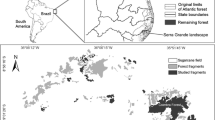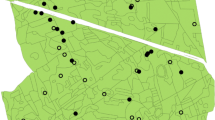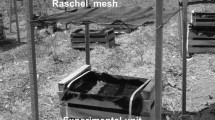Abstract
Many areas of tropical rainforest have been fragmented and the habitat quality of fragments is often poor. For example, on Borneo, many forest fragments are highly degraded by repeated logging of Dipterocarpaceae trees prior to fragmentation, and we examined the viability of enrichment planting as a potential management tool to enhance the conservation value of these forest fragments. We planted seedlings of three dipterocarp species with contrasting light demands and tolerances (Parashorea malaanonan (light demander), Dryobalanops lanceolata (intermediate), Hopea nervosa (shade tolerant)) in eight forest fragment sites (3–3529 ha), and compared seedling performance with four sites in continuous forest. Eighteen months after planting, survival rates of seedlings were equally high in fragment sites (mean survival = 63 %), and in continuous forest sites (mean survival = 68 %). By contrast, seedling growth and herbivory rates were considerably higher in fragments (by 60 % for growth and 45 % for herbivory) associated with higher light environments in degraded forest fragments compared with continuous forest sites. Among the three study species, H. nervosa seedlings had the highest survival rates overall, and P. malaanonan seedlings generally grew fastest and suffered highest herbivory rates. There were no interactions between species performance and the effects of fragment site area, forest structure or soil characteristics of sites suggesting that the three species responded similarly to fragmentation effects. High survival of planted seedlings implies that enrichment planting would be a successful forest management strategy to improve forest quality, and hence conservation value, of fragments.




Similar content being viewed by others
References
Ådjers G, Hadengganan S, Kuusipalo J, Nuryanto K, Vesa L (1995) Enrichment planting of dipterocarps in logged-over secondary forests: effect of width, direction and maintenance method of planting line on selected Shorea species. For Ecol Manag 73(1):259–270
Ashton MS (1995) Seedling growth of co-occurring Shorea species in the simulated light environments of a rain forest. For Ecol Manag 72:1–12
Ashton PS (2004) Dipterocarpaceae. In: Soepadmo E, Saw LG, Chung RCK (eds) Tree flora of Sabah and Sarawak, vol 5. Sabah Forestry Department, Sandakan, pp 63–388
Bagchi R, Press MC, Scholes JD (2010) Evolutionary history and distance dependence control survival of dipterocarp seedlings. Ecol Lett 13:51–59
Bagchi R, Philipson CD, Slade EM, Hector A, Phillips S, Villanueva JF, Lewis OT, Lyal CHC, Nilus R, Madran A, Scholes JD, Press MC (2011) Impacts of logging on density-dependent predation of dipterocarp seeds in a South East Asian rainforest. Philos T R Soc B 366:3246–3255
Basset Y, Charles E, Hammond DS, Brown VK (2001) Short-term effects of canopy openness on insect herbivores in a rain forest in Guyana. J Appl Ecol 38:1045–1058
Bawa KS (1998) Conservation of genetic resources in the Dipterocarpaceae. In: Appanah S, Turnbull JM (eds) A review of Dipterocarps: taxonomy ecology and silviculture. CIFOR, Bogor
Bebber D, Brown N, Speight M, Moura-Costa P, Wai YS (2002a) Spatial structure of light and dipterocarp seedling growth in a tropical secondary forest. For Ecol Manag 157:65–75
Bebber D, Brown N, Speight M (2002b) Drought and root herbivory in understorey Parashorea Kurz (Dipterocarpaceae) seedlings in Borneo. J Trop Ecol 18:795–804
Benitez-Malvido J (1998) Impact of Forest Fragmentation on Seedling Abundance in a Tropical Rain Forest. Conserv Biol 12:380–389
Benitez-Malvido J, Martinez-Ramos M (2003) Impact of forest fragmentation on understory plant species richness in Amazonia. Conserv Biol 17:389–400
Brown ND, Whitmore TC (1992) Do dipterocarp seedlings really partition tropical rain-forest gaps. Philos T Roy Soc B 335:369–378
Brown N, Press M, Bebber D (1999) Growth and survivorship of dipterocarp seedlings: differences in shade persistence create a special case of dispersal limitation. Philos T R Soc B 354:1847–1855
Burnham KP, Anderson DR (2002) Multimodel selection and multimodel inferences: a practical information theoretic approach, 2nd edn. Springer, New York
Coley PD, Barone JA (1996) Herbivory and plant defences in tropical forests. Annu Rev Ecol Syst 27:305–335
Costelloe B, Collen B, Milner-Gulland EJ, Craigie ID, McRae L, Rondinini C, Nicholson E (2015) Global biodiversity indicators reflect the modeled impacts of protected area policy change. Conserv Lett 9:14–20
Dantas de Paula M, Groeneveld J, Huth A (2015) Tropical forest degradation and recovery in fragmented landscapes—simulating changes in tree community, forest hydrology and carbon balance. Global Ecol Conserv 3:664–677
Didham RK, Lawton JH (1999) Edge structure determines the magnitude of changes in microclimate and vegetation structure in tropical forest fragments. Biotropica 31:17–30
Eichhorn MP, Fagan KC, Compton SG, Dent DH, Hartley SE (2007) Explaining leaf herbivory rates on tree seedlings in a Malaysian rain forest. Biotropica 39:416–421
Eichhorn MP, Nilus R, Compton SG, Hartley SE, Burslem DFRP (2010) Herbivory of tropical rain forest tree seedlings correlates with future mortality. Ecology 91:1092–1101
Ewers RM, Banks-Leite C (2013) Fragmentation Impairs the Microclimate Buffering Effect of Tropical Forests. Plos One 8
Faraway JJ (2006) Extending the linear model with R. CRC Press, Boca Raton
Ferreira LV, Laurance WF (1997) Effects of forest fragmentation on mortality and damage of selected trees in central Amazonia. Conserv Biol 11:797–801
Foster WA, Snaddon JL, Turner EC, Fayle TM, Cockerill TD, Ellwood MDF, Broad GR, Chung AYC, Eggleton P, Khen CV, Yusah KM (2011) Establishing the evidence base for maintaining biodiversity and ecosystem function in the oil palm landscapes of South East Asia. Philos T R Soc B 366:3277–3291
Grueber CE, Nakagawa S, Laws RJ, Jamieson IG (2011) Multimodel inference in ecology and evolution: challenges and solutions. J Evolution Biol 24:699–711
Gustafsson M, Gustafsson L, Alloysius D, Falck J, Yap SW, Karlsson A, Ilstedt U (2016) Life history traits predict the response to increased light among 33 tropical rainforest tree species. For Ecol Manag 362:20–28
Harrison S, Bruna E (1999) Habitat fragmentation and large-scale conservation: what do we know for sure? Ecography 22:225–232
Hector A, Philipson C, Saner P, Chamagne J, Dzulkifli D, O’Brien M, Snaddon JL, Ulok P, Weilenmann M, Reynolds G, Godfray HCJ (2011) The Sabah Biodiversity Experiment: a long-term test of the role of tree diversity in restoring tropical forest structure and functioning. Philos T R Soc B 366:3303–3315
Hill JK, Gray MA, Khen CV, Benedick S, Tawatao N, Hamer KC (2011) Ecological impacts of tropical forest fragmentation: how consistent are patterns in species richness and nestedness? Philos T R Soc B 366:3265–3276
King DA, Davies SJ, Tan S, Noor NSM (2006) The role of wood density and stem support costs in the growth and mortality of tropical trees. J Ecol 94:670–680
Koh LP, Wilcove DS (2008) Is oil palm agriculture really destroying tropical biodiversity? Conserv Lett 1:60–64
Lamb D, Erskine PD, Parrotta JA (2005) Restoration of degraded tropical forest landscapes. Science 310:1628–1632
Laurance WF, Camargo JLC, Luizao RCC, Laurance SG, Pimm SL, Bruna EM, Stouffer PC, Williamson GB, Benitez-Malvido J, Vasconcelos HL, Van Houtan KS, Zartman CE, Boyle SA, Didham RK, Andrade A, Lovejoy TE (2011) The fate of Amazonian forest fragments: a 32-year investigation. Biol Conserv 144:56–67
Lucey JM, Tawatao N, Senior MJM, Khen CV, Benedick S, Hamer KC, Woodcock P, Newton RJ, Bottrell SH, Hill JK (2014) Tropical forest fragments contribute to species richness in adjacent oil palm plantations. Biol Conserv 169:268–276
Magnago LFS, Magrach A, Laurance WF, Martins SV, Meira-Neto JAA, Simonelli M, Edwards DP (2015) Would protecting tropical forest fragments provide carbon and biodiversity co-benefits under REDD+? Glob Change Biol. doi:10.1111/gcb.12937
Marsh CW, Greer AG (1992) Forest land-use in Sabah, Malaysia: an introduction to Danum Valley. Philos T R Soc B 335:331–339
Massey FP, Massey K, Press MC, Hartley SE (2006) Neighbourhood composition determines growth, architecture and herbivory in tropical rain forest tree seedlings. J Ecol 94:646–655
McDowell N, Pockman WT, Allen CD, Breshears DD, Cobb N, Kolb T, Plaut J, Sperry J, West A, Williams DG, Yepez EA (2008) Mechanisms of plant survival and mortality during drought: why do some plants survive while others succumb to drought? New Phytol 178:719–739
Newman MF, Burgess PF, Whitmore TC (1996) Manuals of Dipterocarps for foresters: Borneo island light hardwoods. CIFOR and Royal Botanical Garden, Edinburgh
Newman MF, Burgess PF, Whitmore TC (1998) Manuals of Dipterocarps for foresters: Borneo island medium and heavy Hardwoods. CIFOR and Royal Botanical Garden, Eidinburgh
Novotny V, Basset Y, Miller SE, Weiblen GD, Bremer B, Cizek L, Drozd P (2002) Low host specificity of herbivorous insects in a tropical forest. Nature 416:841–844
Nussbaum R, Anderson J, Spencer T (1995) Factors limiting the growth of indigenous tree seedlings planted on degraded rainforest soils in Sabah, Malaysia. For Ecol Manag 74:149–159
Paine CE, Stenflo M, Philipson CD, Saner P, Bagchi R, Ong RC, Hector A (2012) Differential growth responses in seedlings of ten species of Dipterocarpaceae to experimental shading and defoliation. J Trop Ecol 28:377–384
Palmiotto PA, Davies SJ, Vogt KA, Ashton MS, Vogt DJ, Ashton PS (2004) Soil-related habitat specialization in dipterocarp rain forest tree species in Borneo. J Ecol 92:609–623
Philipson CD, Dent DH, O’Brien MJ, Chamagne J, Dzulkifli D, Nilus R, Philips S, Reynolds G, Saner P, Hector A (2014) A trait-based trade-off between growth and mortality: evidence from 15 tropical tree species using size-specific relative growth rates. Ecol Evol 4:3675–3688
Pinard MA, Barker MG, Tay J (2000) Soil disturbance and post-logging forest recovery on bulldozer paths in Sabah, Malaysia. For Ecol Manag 130:213–225
Portela RDQ, Santos FAM (2009) Mortality and mechanical damage of seedlings in different size fragments of the Brazilian Atlantic Forest. J Trop Ecol 50:267–275
R Core Team (2013) R: a language and environment for statistical computing. R Foundation for Statistical Computing, Vienna. http://www.R-project.org. Accessed 30 Nov 2015
Rao M, Terborgh J, Nunez P (2001) Increased herbivory in forest isolates: implications for plant community structure and composition. Conserv Biol 15:624–633
Reynolds G, Payne J, Sinun W, Mosigil G, Walsh RPD (2011) Changes in forest land use and management in Sabah, Malaysian Borneo, 1990–2010, with a focus on the Danum Valley region. Philos T R Soc B 366:3168–3176
Romell E, Hallsby G, Karlsson A, Garcia C (2008) Artificial canopy gaps in a Macaranga spp. dominated secondary tropical rain forest—effects on survival and above ground increment of four under-planted dipterocarp species. For Ecol Manag 255:1452–1460
Sakai A, Visaratana T, Vacharangkura T, Thai-Ngam R, Nakamura S (2014) Growth performance of four dipterocarp species planted in a Leucaena leucocephala plantation and in an open site on degraded land under a tropical monsoon climate. Jarq-Jpn Agr Res Q 48:95–104
Scariot A (2000) Seedling mortality by litterfall in Amazonian forest fragments. Biotropica 32:662–669
Senior MJM, Brown E, Villalpando P, Hill JK (2014) Increasing the scientific evidence base in the “High Conservation Value” (HCV) approach for biodiversity conservation in managed tropical landscapes. Conserv Lett. doi:10.1111/conl.12148
Stanturf JA, Palik BJ, Dumroese RK (2014) Contemporary forest restoration: a review emphasizing function. For Ecol Manag 331:292–323
Strauss SY, Agrawal AA (1999) The ecology and evolution of plant tolerance to herbivory. Trends Ecol Evol 14:179–185
Tawatao N, Lucey JM, Senior M, Benedick S, Khen CV, Hill JK, Hamer KC (2014) Biodiversity of leaf-litter ants in fragmented tropical rainforests of Borneo: the value of publically and privately managed forest fragments. Biodivers Conserv 23:3113–3126
Terborgh J, Lopez L, Nunez P, Rao M, Shahabuddin G, Orihuela G, Riveros M, Ascanio R, Adler GH, Lambert TD, Balbas L (2001) Ecological meltdown in predator-free forest fragments. Science 294:1923–1926
Tuomela K, Kuusipalo J, Vesa L, Nuryanto K, Sagala APS, Adjers G (1996) Growth of dipterocarp seedlings in artificial gaps: an experiment in a logged-over rainforest in South Kalimantan, Indonesia. Forest Ecol Manag 81:95–100
Walsh RPD, Newbery DM (1999) The ecoclimatology of Danum, Sabah, in the context of the world’s rainforest regions, with particular reference to dry periods and their impact. Philos T R Soc B 354:1869–1883
Warton DI, Hui FKC (2011) The arcsine is asinine: the analysis of proportions in ecology. Ecology 92:3–10
Whitmore TC, Brown ND (1996) Dipterocarp seedling growth in rain forest canopy gaps during six and a half years. Philos T Roy Soc B 351:1195–1203
Wise MJ, Abrahamson WG (2005) Beyond the compensatory continuum: environmental resource levels and plant tolerance of herbivory. Oikos 109:417–428
Woods P (1989) Effects of logging, drought, and fire on structure and composition of tropical forests in Sabah, Malaysia. Biotropica 21:290–298
Wyatt-Smith J (1963) Manual of Malayan silviculture for inland forests, vol 1. Forest Research Institute Malaysia, Kuala Lumpur
Yeong KL, Reynolds G, Hill JK (2016) Leaf litter decomposition rates in degraded and fragmented tropical rainforests of Borneo. Biotropica. doi:10.1111/btp.12319
Zipperlen SW, Press MC (1996) Photosynthesis in relation to growth and seedling ecology of two dipterocarp rain forest tree species. J Ecol 84:863–876
Acknowledgments
This study was part of a PhD project funded by the Earthwatch Institute, supported by Shell PLC, and supervised by JKH, GR and Dr. John Tay (Universiti Malaysia Sabah). We thank the SE Asia Rainforest Research Partnership (SEARRP), Yayasan Sabah, Sabah Forestry Department, the Danum Valley Management Committee and Wilmar International Limited for permission to access research sites and facilities. We also thank Adrian Karolus, Phillip Ulok, Remmy Murus, Mohd. Edri, Mohd. Azlin, Amat Ahmad, Mohd. Herdam and Udin Jaga for assistance in the field. We thank Dr. Jennifer Lucey and Sarah Scriven for their comments on the paper.
Author contribution
All authors conceived and designed the experiments and wrote the manuscript. YKL performed the experiments, carried out the fieldwork, and analyzed the data.
Author information
Authors and Affiliations
Corresponding author
Ethics declarations
Conflicts of interest
All authors declare that they have no conflicts of interests.
Additional information
Communicated by Peter Ashton.
Electronic supplementary material
Below is the link to the electronic supplementary material.
Rights and permissions
About this article
Cite this article
Yeong, K.L., Reynolds, G. & Hill, J.K. Enrichment planting to improve habitat quality and conservation value of tropical rainforest fragments. Biodivers Conserv 25, 957–973 (2016). https://doi.org/10.1007/s10531-016-1100-3
Received:
Revised:
Accepted:
Published:
Issue Date:
DOI: https://doi.org/10.1007/s10531-016-1100-3




